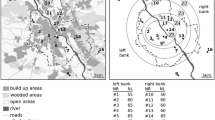Abstract
On the basis of the results of long-term monitoring, the peculiarities of demographic processes in Sylvaemus uralensis Pall. populations under the peripheral ecological–geographic conditions of the area have been studied. Data of the individual marking and ontogenetic history of animals are presented. Demographic parameters of population, reproduction efficiency, and progeny survival, as well as contributions of various structural groups in the population gene pool were analyzed. The low reproduction activity of the young and the considerable role of the senior age groups in population reproduction were revealed. We have established that changes occur at two structure levels of population: simplification of the age structure and reorganization of the generation structure transformed the genetic information transmission pathways. The transgeneration channel of the transfer of hereditary information is prevailing in pessimum habitats of murine rodents with low reproductive activity of the young stock. In depression years this channel is obligatory and it might cause a reduction in the population genetic heterogeneity.
Similar content being viewed by others
References
Altukhov, Yu.P., Geneticheskie protsessy v populyatsiy-akh (Genetic Processes in Populations), Moscow Aka-demkniga, 2003, 3rd edition.
Kawecki, T.J., Ann. Rev. Ecol. Evol. Syst., 2008, vol. 39, pp. 321–342.
Gaston, K.J., Proc. Roy. Soc. B, 2009, vol. 276, pp. 1395–1406.
Hardie, D.C. and Huchings, J.A., Environ. Rev., 2010, vol. 18, pp. 1–20.
Shilov, I.A., Ekologo-fiziologicheskie osnovy populyat-sionnykh otnoshenii u zhivotnykh (Ecological and Phys-iological Mechanisms of Population Relationships in Animals), Moscow Mos. Gos. Univ., 1977.
Shvarts, S.S., Ekologicheskie zakonomernosti evolyutsii (Ecological Laws of Evolution), Moscow Nauka, 1980.
Shchipanov, N.A., Zool. Zh., 2002, vol. 81, no. 9, pp. 1048–1077.
Bertheir, K., Galan, M., Foltete, J.C., et al., Mol. Ecol., 2005, vol. 14, no. 9, pp. 2861–2871.
Moshkin, M.P. and Shilova, S.A., Usp. Sovrem. Biol., 2008, vol. 128, no. 3, pp. 307–320.
Ivanter, E.V., Printsipy Ekol., 2012, no. 2, pp. 72–76.
Milishnikov, A.N., Dokl. Biol. Sci., 2005, vol. 404, no. 5, pp. 382–385.
Kolcheva, N.E., Vestn. Orenburg. Univ., 2011, no. 12, pp. 90–92.
Olenev, G.V., Ekologiya, 2002, no. 5, pp. 341–350.
Fazalova, V.R., Semovskii, S.V., Shcherbakov, D.Yu., and Men’e, G., Genetika, 2007, vol. 43, no. 9, pp. 1172–1180.
Grigorkina, E.B. and Olenev, G.V., Dokl. Biol. Sci., 2012, vol. 443, no. 1, pp. 91–93.
Author information
Authors and Affiliations
Corresponding author
Additional information
Original Russian Text © N.E. Kolcheva, 2015, published in Doklady Akademii Nauk, 2015, Vol. 463, No. 2, pp. 234–236.
Rights and permissions
About this article
Cite this article
Kolcheva, N.E. Demographic processes and genetic variability of mouse populations at the ecological–geographic periphery. Dokl Biol Sci 463, 190–192 (2015). https://doi.org/10.1134/S0012496615040031
Received:
Published:
Issue Date:
DOI: https://doi.org/10.1134/S0012496615040031



